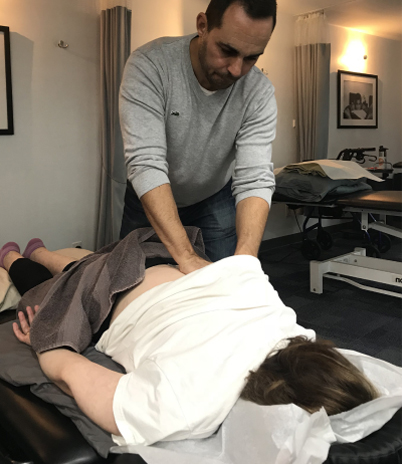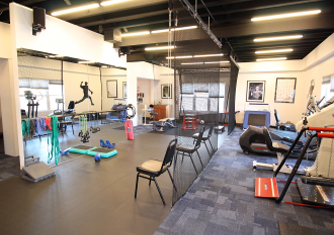Pilates is a form of exercise that focuses on strengthening the core muscles, improving flexibility, and enhancing overall body awareness. Developed by Joseph Pilates in the early 20th century, pilates emphasizes precise movements, proper alignment, and controlled breathing to build strength, endurance, and stability. Pilates exercises can be performed on a mat or using specialized equipment such as reformers, chairs, and barrels.
In physical therapy, pilates is used as a therapeutic tool to help patients improve their posture, balance, strength, and coordination. Physical therapists may incorporate pilates exercises into rehabilitation programs to address a wide range of musculoskeletal conditions, including back pain, neck pain, joint injuries, and post-surgical rehabilitation.
Physical therapists may tailor pilates exercises to meet the specific needs and goals of each patient, focusing on areas of weakness, imbalance, or dysfunction.
Brooklyn Body Works Physical Therapy is staffed with a professional and caring team of experts with clinical experience in Pilates. Browse through our physical therapist profiles to learn how they can help you with restoring functionality.
Pilates exercises can help patients receiving physical therapy in various ways:
Core stabilization: Pilates focuses on strengthening the core muscles, including the abdominals, back, and pelvic floor, which are essential for providing stability and support to the spine and pelvis. Improved core strength can help patients with back pain, postural issues, and movement dysfunction.
Improved posture: Pilates emphasizes proper alignment and body awareness, helping patients correct postural imbalances and maintain a more neutral spine position. Better posture can reduce strain on the muscles and joints, leading to improved movement efficiency and reduced pain.
Enhance flexibility and mobility: Pilates exercises incorporate dynamic stretching and controlled movements that can improve flexibility in muscles and joints, enhancing range of motion and reducing stiffness. This can be particularly beneficial for patients recovering from injuries or surgeries.
Balance and coordination: Pilates exercises challenge balance, coordination, and proprioception, which are essential for functional movement patterns and injury prevention. By practicing pilates, patients can enhance their balance and coordination skills, reducing the risk of falls and improving overall stability.
Mind-body connection: Pilates promotes mindfulness and body awareness, encouraging patients to focus on their movements, breathing, and muscle engagement. This mind-body connection can help patients improve movement control, reduce stress, and enhance relaxation, leading to a more holistic approach to rehabilitation.
Functional movement training: Pilates exercises often mimic everyday movements and activities, making them highly applicable to real-life scenarios. By incorporating functional movement training into physical therapy sessions, patients can improve their ability to perform daily tasks with greater ease and efficiency.
Injury prevention: Pilates can help strengthen muscles, improve joint stability, and enhance movement mechanics, reducing the risk of injuries during physical activities or sports. By incorporating Pilates into their rehabilitation program, patients can build a strong foundation for injury prevention and long-term health.
Overall, integrating Pilates exercises into physical therapy sessions can provide patients with a comprehensive approach to rehabilitation, addressing core strength, body mechanics, movement patterns, and overall fitness to support their recovery and long-term well-being.
Pilates can include techniques or exercises such as:
Brooklyn Body Works Physical Therapy began as an idea to bring the highest quality physical therapy to all people in our community. We wanted to offer the best that NYC has in health care while not marginalizing people based on socioeconomic boundaries (race, income, language, religion, etc). We offer a “concierge style service” and continue to accept many commercial insurances, medicare and even medicaid policies.



Since this is a physical therapy session which will require a physical examination and therapeutic exercise (varies by patient), we ask all our patients to come prepared. Please come dressed in loose fitted clothing that will allow for easy mobility, comfort, and access to the area of complaint. In addition we recommend sneakers with soles that grip to prevent slips or falls.
The need for a referral depends on what type of insurance you have. Most insurance plans do not require one, however some insurances do. For example, if you have HIP, you will need a referral from your primary care physician. We ask that you check to see what your health insurance plan requires prior to your initial visit. If you are unsure, please contact our front office and we’ll do our best to determine whether or not you require a referral.
To get in contact with us, click on the following link to view information pertaining to each office.
Each patients case and diagnosis is unique and requires the development of an individualized plan of care. Your physical therapist will give you an estimate of the number of sessions needed to reach a level of “feeling better”, during your initial evaluation.
Over time the number of visits may increase or decrease from the initial estimate, based on the progress made.
Brooklyn Body Works Physical Therapy accepts many of the available major insurance plans as well as alternate payment options, including cash/self-pay, to make our services accessible and affordable. Please visit the link below to view all information pertaining to Payment Options.